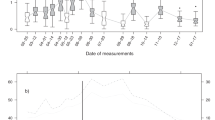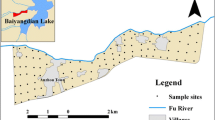Abstract
Soil heterotrophic respiration fluxes at field scale may exhibit a substantial spatial variability. The aim of this study was (1) to elucidate the role of soil temperature and different carbon fractions on heterotrophic soil respiration and (2) to test by which of three different statistical approaches (multiple regression, external drift kriging and simulated annealing) such influences may be best represented. Chamber-based measurements of respiration fluxes were carried out within a 180 × 40 m bare soil plot. Soil temperature was measured simultaneously to the flux measurements. Further, we recorded total soil organic carbon content, apparent electrical conductivity as well as mid-infrared spectroscopy-based carbon fractions as co-variates in addition to basic soil properties like stone content and texture. A stepwise multiple linear regression procedure was used to spatially predict bare soil respiration from the co-variates. The results showed that the particulate organic matter (POM) fraction and terrain elevation were able to explain the spatial pattern of heterotrophic soil respiration (R 2 = 0.45). In a second step we applied external drift kriging to determine the improvement of using co-variates in an estimation procedure in comparison to ordinary kriging. The maximum relative improvement using the co-variates in terms of the root mean square error was 16%. In a third step we applied simulated annealing to perform stochastic simulations conditioned with external drift kriging to generate more realistic spatial patterns of heterotrophic respiration at plot scale. The conditional stochastic simulations revealed a significantly improved reproduction of the probability density function, the G-statistics value increased from 0.36 to 0.92. Further, the error in the reproduction of the semivariogram of the original point data decreased by more than one order of magnitude. All this confirmed that the mapping of soil respiration patterns may be significantly improved when considering terrain elevation and spatial heterogeneity of POM in combination with a conditional stochastic simulation.







Similar content being viewed by others
References
Ahmed S, DeMarsily G (1987) Comparison of geostatistical methods for estimating transmissivity using data on transmissivity and specific capacity. Water Resour Res 23:1717–1737
Aiken RM, Jawson MD, Grahammer K, Polymenopoulos AD (1991) Positional, spatially correlated and random components of variability in carbon dioxide efflux. J Environ Qual 20:301–308
Akaike H (1973) Information theory as an extension of the likelihood principle. In: Petrov BN, Csaki F (eds) International symposium on information theory. Akademiai Kiado, Budapest, pp 267–281
Amelung W, Zech W (1999) Minimisation of organic matter disruption during particle-size fractionation of grassland epipedons. Geoderma 92:3–85
Bornemann L, Welp G, Brodowski S, Rodionov A, Amelung W (2008) Rapid assessment of black carbon in soil organic matter using mid-infrared spectroscopy. Org Geochem 39:1537–1544
Bornemann L, Welp G, Amelung W (2010) Particulate organic matter at field scale–rapid acquisition using mid-infrared spectroscopy. Soil Sci Soc Am J 74:1147–1156. doi:10.2136/sssaj2009.0195
Brodowski S, Amelung W, Haumaier L, Abetz C, Zech W (2005) Morphological and chemical properties of black carbon in physical soil fractions as revealed by scanning electron microscopy and energy-dispersive X-ray spectroscopy. Geoderma 128:116–129
Cambardella CA, Moormann TB, Novak JM, Parkin TB, Karlen DL, Turco RF, Konopka AE (1994) Field-scale variability of soil properties in central Iowa soils. Soil Sci Soc Am J 58:1501–1511
Deutsch CV (1997) Direct assessment of local accuracy and precision. In: Baafi EY, Schofield NA (eds) Geostatistics Wollongong’96. Kluwer, Dordrecht, pp 115–125
Deutsch CV, Cockerham PW (1994) Practical considerations in the application of simulated annealing to stochastic simulation. Math Geol 26:67–82
Deutsch CV, Journel AG (1998) GSLIB: geostatistical software library and user’s guide, 2nd edn. Oxford University Press, New York 369
Dugas WA (1993) Micrometeorological and chamber measurements of CO2 flux from bare soil. Agric Meteorol 67:115–128
Ersahin S (2003) Comparing ordinary kriging and cokriging to estimate infiltration rate. Soil Sci Soc Am J 67:1848–1855
Fang C, Moncrieff JB, Gholz HL, Clark L (1998) Soil CO2 efflux and its spatial variation in a Florida slash pine plantation. Plant Soil 205:135–146
Foti Sz, Balogh J, Nagy Z, Ürmös Zs, Bartha S, Tuba Z (2008) Temporal and spatial variability and pattern of soil respiration in loess grassland. Community Ecol 9:57–64
Goovaerts P (2000) Estimation or simulation of soil properties? An optimization problem with conflicting criteria. Geoderma 97:165–186
Goovaerts P (2001) Geostatistical modelling of uncertainty in soil science. Geoderma 103:3–26
Graf A, Prolingheuer N, Schickling A, Schmidt M, Schneider K, Schüttemeyer D, Herbst M, Huisman JA, Weihermüller L, Scharnagl B, Steenpass C, Harms R, Vereecken H (2010) Temporal downscaling of soil CO2 efflux measurements based on time-stable patterns. Vadose Zone J 10:239–251
Han G, Zhou G, Xu Z, Yang Y, Liu J, Shi K (2007) Biotic and abiotic factors controlling the spatial and temporal variation of soil respiration in an agricultural ecosystem. Soil Biol Biochem 39:418–425
Heimann M, Reichstein M (2008) Terrestrial ecosystem carbon dynamics and climate feedbacks. Nature 451:289–292. doi:10.1038/nature06591
Herbst M, Prolingheuer N, Graf A, Huisman JA, Weihermüller L, Vanderborght J (2009) Characterization and understanding of bare soil respiration spatial variability at plot scale. Vadose Zone J 8:762–771
Herbst M, Prolingheuer N, Graf A, Huisman JA, Weihermüller L, Vanderborght J, Vereecken H (2010) Multivariate conditional stochastic simulation of soil heterotrophic respiration at plot scale. Geoderma 160:74–82. doi:10.1016/j.geoderma.2009.11.018
Hibbard KA, Law BE, Reichstein M, Sulzman J (2005) An analysis of soil respiration across northern hemisphere temperate ecosystems. Biogeochemistry 73(1):29–70
IPCC (2007) Climate change 2007: the physical science basis. Summary for policymakers
ISO 10694 (1995) Soil quality—determination of organic and total carbon after dry combustion (elemental analysis). Beuth-Verlag, Berlin
ISO 11277 (2002) Soil quality—determination of particle size distribution in mineral soil material—method by sieving and sedimentation. Beuth-Verlag, Berlin
Jost G, Heuvelink GBM, Papritz A (2005) Analysing the space-time distribution of soil water storage of a forest ecosystem using spatio-temporal kriging. Geoderma 128:258–273
Khomik M, Altaf Arain M, McCaughey JH (2006) Temporal and spatial variability of soil respiration in a boreal mixwood forest. Agric For Meteorol 140:244–256
Konda R, Ohta S, Ishizuka S, Arai S, Ansori S, Tanaka N, Hardjono A (2008) Spatial structures of N2O, CO2, and CH4 fluxes from Acacia mangium plantation soils during a relatively dry season in Indonesia. Soil Biol Biochem 40:3021–3030. doi:10.1016/j.soilbio.2008.08.022
Kosugi Y, Mitani T, Itoh M, Noguchi S, Tani M, Matsuo N, Takanashi S, Ohkubo S, Nik AR (2007) Spatial and temporal variation in soil respiration in a Southeast Asian tropical rainforest. Agric For Meteorol 147:35–47
Kravchenko AN, Hao X (2008) Management practice effects on spatial variability characteristics of surface mineralizable C. Geoderma 144:387–394
La Scala N, Marques J Jr, Pereira GT, Cora JE (2000) Short-term temporal changes in the spatial variability model of CO2 emissions from a Brazilian bare soil. Soil Biol Biochem 32:1459–1462
Lal R (2004) Soil carbon sequestration to mitigate climate change. Geoderma 123:1–22
Larocque G, Dutilleul P, Pelletier B, Fyles JW (2006) Conditional Gaussian co-simulation of regionalized components of soil variation. Geoderma 134:1–16
Legendre P (1993) Spatial autocorrelation: trouble or new paradigm? Ecology 74:1659–1673
Leuangthong O, McLennan JA, Deutsch CV (2004) Minimum acceptance criteria for geostatistical realizations. Nat Resour Res 13(3):131–141
Martin JG, Bolstad PV (2009) Variation of soil respiration at three spatial scales: components within measurements, intra-site variation and patterns on the landscape. Soil Biol Biochem 41:530–543
Minasny B, McBratney AB (2007) Spatial prediction of soil properties using EBLUP with the Matérn covariance function. Geoderma 140:324–336
Ohashi M, Kumagai T, Kume T, Gyokusen K, Saitoh TM, Suzuki M (2008) Characteristics of soil CO2 efflux variability in a seasonal tropical rainforest in Borneo Island. Biogeochemistry 90:275–289
Ohkubo S, Kosugi Y, Takanashi S, Mitani T, Tani M (2007) Comparison of the eddy covariance and automated closed chamber methods for evaluating nocturnal CO2 exchange in a Japanese cypress forest. Agric For Meteorol 142:50–65
Pacific J, McGlynn BL, Rivieros-Iregui DA, Welsch D, Epstein H (2011) Landscape structure, groundwater dynamics, and soil water content influence soil respiration across riparian-hillslope transitions in the Tenderfoot Creek Experimental Forest, Montana. Hydrol Process 25:811–827. doi:10.1002/hyp.7870
Panosso AR, Marques J Jr, Pereira GT, La Scala Jr N (2009) Spatial and temporal variability of soil CO2 emission in a sugarcane area under green and slash-and-burn managements. Soil Tillage Res 105:275–282. doi:10.1016/j.still.2009.09.008
Pätzold S, Mertens FM, Bornemann L, Koleczek B, Franke J, Feilhauer H, Welp G (2008) Soil heterogeneity at the field scale: a challenge for precision crop protection. Precis. Agric. 9:367–390
Pringle MJ, Lark RM (2006) Spatial analysis of model error, illustrated by soil carbon dioxide emissions. Vadose Zone J 5:168–183
Pumpanen J, Kolari P, Ilvesniemi H, Minkkinen K, Vesala T, Niinistö S, Lohila A, Larmola T, Morero M, Pihlatie M, Janssens I, Yuste JC, Grünzweig JM, Reth S, Subke J-A, Savage K, Kutsch W, Østreng G, Ziegler W, Anthoni P, Lindroth A, Hari P (2004) Comparison of different chamber techniques for measuring soil CO2 efflux. Agric For Meteorol 123:159–176
Rivero RG, Grunwald S, Bruland GL (2007) Incorporation of spectral data into multivariate geostatistical models to map soil phosphorus variability in a Florida wetland. Geoderma 140:428–443
Rochette P, Desjardins RI, Pattey E (1991) Spatial and temporal variability of soil respiration in agricultural fields. Can J Soil Sci 71:189–196
Simbahan G, Dobermann A, Goovaerts P, Ping J, Haddix ML (2006) Fine-resolution mapping of soil organic carbon based on multivariate secondary data. Geoderma 132:471–489
Skjemstad JO, Spouncer LR, Cowie B, Swift RS (2004) Calibration of the Rothamsted organic carbon turnover model (RothC Ver. 26.3), using measurable soil organic pools. Aust J Soil Res 42:79–88
Smith JU, Smith P, Monaghan R, MacDonald J (2002) When is a measured soil organic matter fraction equivalent to a model pool? Eur J Soil Sci 53:405–416
Tang JW, Baldocchi DD (2005) Spatial-temporal variation in soil respiration in an oak-grass savannah ecosystem in California and its partitioning into autotrophic and heterotrophic components. Biogeochemistry 73:183–207
Webster KL, Creed IF, Bourbonniere RA, Beall FD (2008) Controls on the heterogeneity of soil respiration in a tolerant hardwood forest. J Geophys Res 113:G03018. doi:10.1029/2008JG000706
Weihermüller L, Huisman JA, Lambot S, Herbst M, Vereecken H (2007) Mapping the spatial variation of soil water content at the field scale with different ground penetrating radar techniques. J Hydrol 340:205–216
Yanai J, Mishima A, Funakawa S, Akshalov K, Kosaki T (2005) Spatial variability of organic matter dynamics in the semi-arid croplands of northern Kazakhstan. Soil Sci Plant Nutr 51:261–269
Zimmermann M, Leifeld J, Schmidt MWI, Smith P, Fuhrer J (2007) Measured soil organic matter fractions can be related to pools in the RothC model. Eur J Soil Sci 58:658–667
Acknowledgments
This research was supported by the German Research Foundation DFG (Transregional Collaborative Research Centre 32—Patterns in Soil–Vegetation–Atmosphere Systems: Monitoring, modelling and data assimilation). Alexander Graf would like to thank the DFG for funding within the project “Links between local scale and catchment scale measurements and modelling of gas exchange processes over land surfaces”. Thanks to R. Harms and M. Hank for the help with some of the measurements.
Author information
Authors and Affiliations
Corresponding author
Rights and permissions
About this article
Cite this article
Herbst, M., Bornemann, L., Graf, A. et al. A geostatistical approach to the field-scale pattern of heterotrophic soil CO2 emission using covariates. Biogeochemistry 111, 377–392 (2012). https://doi.org/10.1007/s10533-011-9661-4
Received:
Accepted:
Published:
Issue Date:
DOI: https://doi.org/10.1007/s10533-011-9661-4




